There is hardly a man who has never heard of such a pathology, such as nail fungus. For example, someone who is familiar with the diagnosis of the advertising of pharmaceutical drugs, and someone found out about the disease first-hand, that it is the dermatologist's office, or the computer itself.
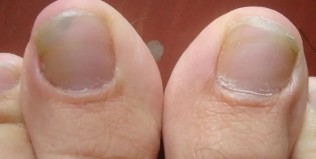
The definition of the
The medical term is onychomycosis (lat. onychomycosis), is Latin and means nail fungi, and is the infectious diseases of a fungal nature. This is the most popular in the world, and the defeat of the nail plate and surrounding soft tissue: according to statistics from the world health organization (who) (world health organization), athlete's foot affects about 27% of the population, and this figure is almost twice the number of fungal infections of the nails, on the fingers.
The type of fungal infection of the nails
Onychomycosis is usually classified according to the appearance of the affected areas. As a symptom, the classification is carried out, as it looks like a fungus on the nails, it is differentialsa of three types, depending on the clinical manifestation:
- atrophic, or onycholitic – in which the nail plate to have a major impact, to the point that the rejection of the nail bed;
- hypertrophic form, they have lost their natural shine of the nail changes its color (white or, on the contrary, in the dark) and the structure (material thickens) with the advent of different types of deformations and even breaks of the edges;
- normotroficheskie – type, which is characterized by the lowest level of injury, where the nail plate is not thickened, while they remain shiny and smooth, but there is still the outside is transformed by the appearance of spots, lines, and other significant changes in the nature of a transparency and a color.
There is another classification according to which of the nail fungus is a member of the series depends on the injury:
- together, in which the pathogenic process, which covers the whole of the nail plate;
- the distal form of an injury, just on the free edge of the nail, acting on the finger pad;
- the proximal, that which destroys the edge of the plate, leaving the nails of the shaft (opposite to the free edge of the nail!);
- the lateral shape of the injuries affecting the side of the nail plate.
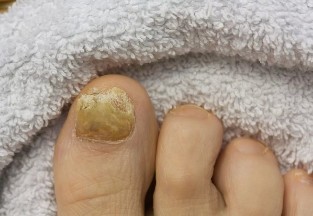
It looks like pathology
Common among the populations of fungal nail disease are similar to other dermatological diseases of a fungal nature. Depending on the stage of the disease, the nails begin to look unhealthy, because it loses its natural Glow and transparency.
From the smooth and flat, they become thickened and deformed, and covered with a different color (usually white or off-yellow) color. The soft tissue is destroyed by the parasite keratin layer is also involved in the inflammatory response, swelling of the.
If you look at the picture of the destruction of the nail plate, the point of view of the dynamics of the disease can be divided into three successive stages:
- In the first instance, there are almost no characters, except for light tarnish, spots, or stripes on the record.
- The so-called serious phase, with the fast-paced in the beginning, all of the symptoms of onychomycosis it becomes clear to you.
- An advanced phase – that is the ultimate degeneration of the nail, which can be complemented by the scent of decaying tissue.
The symptoms of fungus in the nails
The symptoms of athlete's foot corresponds to the chronology of the development of the pathogenic process, the speed of which is dependent on the particular type of pathogen and the individual characteristics of the health status of the patient.
So, how to identify nail fungus before you visit your dermatologist's office? Look closely at the specific symptoms that accompany a fungal infection of the nail plates on my fingers:
- For the first time, the nail plate, they lose their glossy shine becomes dull and rough.
- Then, out of the clear and the color of the nail changes color, becoming whitish, gray, or dirty-yellow.
- The plate thickness is increased.
- On the surface of the body of the error will appear in the form of lines, waves, bumps, curves, etc
- The nail will appear brittle, it will start to exfoliate and crumble.
- The soil, due to the rise of inflammatory processes begin to emit an unpleasant odor.
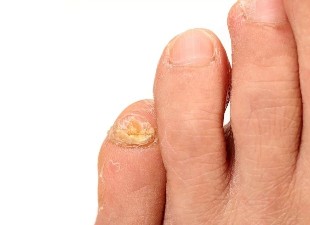
In the end, totally destroyed the exposed nail onycholysis, i.e., flaking, exposing the pringtime of the bed.
The causes of onychomycosis
The pathology is one of the manifestations of the mycosis, which is a loss, that is, in this case, the nail plate of the micro-organisms-dermatophytes of one (or more!) of the three genera:
- Microsporum (a type of canis);
- Trichophyton (rubrum species, 90% of all fungal infections mentagrophytes, interdigitale, and the tonsurans), the leading causative agents fungal infections;
- Epidermophyton (floccosum species).
The representatives of the three generations, United by the collective name of the "nail fungus", when ingested, colonise (i.e., local) keratinized derivative of the epidermis of the skin:
- nails;
- hair.
The reason for the selection of habitats for micro-parasites, that is, within their power, all of the members, and as a source of energy, used a fibrillar protein keratin, so it destroys the nails and the hair.
The modes of infection of
All of the types of diseases caused by pathogens that are transmitted in the manner of the contact:
- a physical contact with an infected person to a healthy;
- the use of the things that come into contact with the affected parts of the body (shoes, personal items, etc.).
Contact with your fingernails or the skin, which has become the habitat of the parasite, which allows you to live the representatives of the fungi, in order to get to the healthy parts of the body.
At the same time that the causative agent of onychomycosis in a position to carry out the invasion of human tissue is required in conditions such as:
- the damage to the integrity of the skin (dermatitis, diaper rash, circulatory system, and diseases of the skin, abrasions, wounds, etc.);
- a weakened immune system;
- the presence of concomitant diseases (genodermatosis, and hemolytic disease, immune -, and endocrine disorders);
- receiving cytostatic and hormonal preparations and antibiotics.
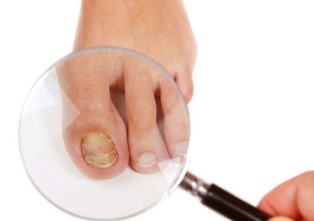
In connection with the foregoing, the penetration of the parasite in the body of a healthy person is not, in all cases, without exception, leads to the clinical manifestations of the disease, or only very weakly expressed in the forms of pathology.
Some of the specific terms and conditions, including a strong immune protection, the person who is outwardly healthy, it becomes a carrier of the parasite, the infection to other people.
How to diagnose the disease
Due to the similarity of the mycotic lesions with mechanical symptoms, and the malformations, and other diseases of the nail plate, on the basis of a clinical diagnosis of a is not just the external signs — what is nail fungus — and more-and it of results of micro-studies.
For the laboratory analysis of the used portions of the land affected, the nails, producing a scraping for fungus of the nails with special tools.
The specific form of the parasite is shown by two of the most useful studies:
- a culture of by placing in a biological sample of the diseased tissue, in particular a nutrient medium;
- molecular-biological methods or by the so-called polymerase chain reaction (PCR).
More precisely, the DNA diagnosis is still not common.
The answer to the question, "how do you identify a nail fungus at home, our experienced dermatologists will advise that you contact a specialist to carry out a comprehensive and of the necessary cases, and differential diagnosis.
What is the danger of nail fungus
A simple nail fungus symptoms, even though it is inconvenient, but the traditional of fungal infections: stratification of the nails, and pain, etc.
However, in some cases, a mycotic join, you can, for example, bacterial infections or diseases, which may occur acutely, with the appearance of blisters, ulcers, weeping areas on the surrounding soft tissues.
Sometimes, the treatment, and in the course of a long-term outpatient (more than 16 weeks!), not ineffective, and the disease is progressing.
How dangerous is nail fungus, long-term, treatable? The inflammatory process in the involved organs and their systems, and then you may need an emergency hospitalization of the patient.
A method for the treatment of fungus of the nails
In the early stages of the disease, conventional medicine uses a conservative method of appointment of the medical treatment.
An Anti-mycotic drug, designed to destroy the fungus underneath the nail, which contain substances that can inhibit the activity of a variety of cliches. For effective treatment it can be used in various pharmacological forms, sometimes complex, be determined as follows:
- pills — for taking orally (through the gastrointestinal tract, typically to the supply of drinking water), administered in the absence of the desired effect of the topical medication;
- ointments, pastes and gels for local, up-to-date application with the use of a drug directly to the affected part of the parasite body;
- aerosols;
- the solution (resorcinol, boric acid, brilliant green, etc.), and the suspension of the application of the tool-soaked wipes for the affected area, or by the use of the drug in the form of a therapeutic bath.
The remedies are usually taken twice a day until resolution of clinical manifestations. In the event of a large-keratosis to facilitate the penetration of the dosage form in the keratin formation is performed partly from a distance. If you have signs of nail fungus indicate, in addition to a secondary bacterial infection, the patient, we recommend a combination of antibiotics.
Important! If you're even system, Anti-mycotic, means to monitor the potential of the functional disorders, which is necessary to produce the biochemical study of the liver (the analysis of blood serum for the presence of bilirubin, in the presence of the enzyme aspartate aminotransferase, gamma-glutamyltransferase, etc.
If the patient's visit, such as nail fungus on my thumb, it suddenly occurs an acute inflammation of the joint and/or severe itchiness, have the option to:
- antihistaminicas (swelling and inflammation);
- desensitize (decrease sensitivity).
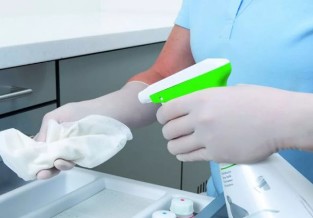
Therapy with the use of pharmacological agents, as a rule of thumb, it is, of course, and it takes a long time period of time of not less than three months!
This is the duration of the treatment was due to the introduction of the pathogen into the structure of the nail, it is time to update it in line with a gradual pruning of the affected areas. If the disease is at a stage at which the treatment does not give positive results, (the form), or the patient – the person of the old, and the possibility that the radical method of surgical removal of the parasite destruction of the nail.
The prevention of
The best treatment is a preventive activity, since preventing is much easier than the first, to settle the fungus on the nail and then get rid of it. This is a good way to avoid infection is to be committed to a strict adherence to the rules of personal hygiene, especially in public places, the imminent danger of the potential contact with native speakers of the mycosis, as well as for the prevention of:
- in primary, the exceptional, the abnormal dryness of the skin, abrasions, minor wounds, and hyperhidrosis, and, in the case of its occurrence – to immediate treatment, for example, aluminium hydrochloride 15%, with ditilinom glycol and 1% for excessive sweating of the feet;
- the secondary disinfection of the particular solutions to the items that come in contact with the source of athlete's foot (shoes, towels, etc.).
Having the correct information, and from which the nail fungus, it is realistic to protect yourself and your family from intrusion, and, in the case of the disease in a timely manner and the appropriate treatments, you can speed up the recovery.






























